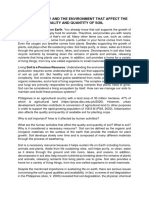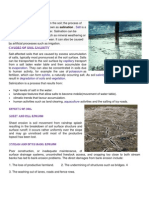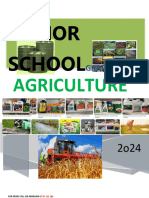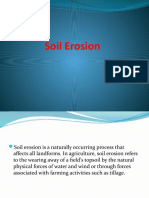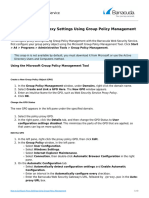0 ratings0% found this document useful (0 votes)
62 viewsHow Do Human Activities Affect Soil?: What's New: Week 6 Earth Science
How Do Human Activities Affect Soil?: What's New: Week 6 Earth Science
Uploaded by
Janel FloresThis document discusses how human activities affect soil quality. It identifies farming, construction, and waste disposal as major activities that can degrade soils. Farming can strip away protective plant cover, leading to erosion from wind and rain. It can also pollute soils with excess fertilizers. Construction activities remove protective cover and can cause erosion, while waste disposal without proper lining of landfills can release toxins into soils and groundwater. The document proposes solutions like conservation tillage, crop rotation, terracing, and water control structures to reduce erosion and pollution from these human activities. Educating farmers and land users on sustainable practices is important to protect soils for the future.
Copyright:
© All Rights Reserved
Available Formats
Download as DOCX, PDF, TXT or read online from Scribd
How Do Human Activities Affect Soil?: What's New: Week 6 Earth Science
How Do Human Activities Affect Soil?: What's New: Week 6 Earth Science
Uploaded by
Janel Flores0 ratings0% found this document useful (0 votes)
62 views11 pagesThis document discusses how human activities affect soil quality. It identifies farming, construction, and waste disposal as major activities that can degrade soils. Farming can strip away protective plant cover, leading to erosion from wind and rain. It can also pollute soils with excess fertilizers. Construction activities remove protective cover and can cause erosion, while waste disposal without proper lining of landfills can release toxins into soils and groundwater. The document proposes solutions like conservation tillage, crop rotation, terracing, and water control structures to reduce erosion and pollution from these human activities. Educating farmers and land users on sustainable practices is important to protect soils for the future.
Original Title
RESEARCH WHATS NEW
Copyright
© © All Rights Reserved
Available Formats
DOCX, PDF, TXT or read online from Scribd
Share this document
Did you find this document useful?
Is this content inappropriate?
This document discusses how human activities affect soil quality. It identifies farming, construction, and waste disposal as major activities that can degrade soils. Farming can strip away protective plant cover, leading to erosion from wind and rain. It can also pollute soils with excess fertilizers. Construction activities remove protective cover and can cause erosion, while waste disposal without proper lining of landfills can release toxins into soils and groundwater. The document proposes solutions like conservation tillage, crop rotation, terracing, and water control structures to reduce erosion and pollution from these human activities. Educating farmers and land users on sustainable practices is important to protect soils for the future.
Copyright:
© All Rights Reserved
Available Formats
Download as DOCX, PDF, TXT or read online from Scribd
Download as docx, pdf, or txt
0 ratings0% found this document useful (0 votes)
62 views11 pagesHow Do Human Activities Affect Soil?: What's New: Week 6 Earth Science
How Do Human Activities Affect Soil?: What's New: Week 6 Earth Science
Uploaded by
Janel FloresThis document discusses how human activities affect soil quality. It identifies farming, construction, and waste disposal as major activities that can degrade soils. Farming can strip away protective plant cover, leading to erosion from wind and rain. It can also pollute soils with excess fertilizers. Construction activities remove protective cover and can cause erosion, while waste disposal without proper lining of landfills can release toxins into soils and groundwater. The document proposes solutions like conservation tillage, crop rotation, terracing, and water control structures to reduce erosion and pollution from these human activities. Educating farmers and land users on sustainable practices is important to protect soils for the future.
Copyright:
© All Rights Reserved
Available Formats
Download as DOCX, PDF, TXT or read online from Scribd
Download as docx, pdf, or txt
You are on page 1of 11
What’s New: Week 6 Earth Science
How do human
activities affect soil?
Submitted by: Janel P. Flores
Section: Stem 11 - T
Submitted to: Ma’am Lou Itoc Cabugo
I. Introduction
Soil, the biologically active, porous medium that has
developed in the uppermost layer of Earth’s crust. Soil is
one of the principal substrata of life on Earth, serving as a
reservoir of water and nutrients, as a medium for the
filtration and breakdown of injurious wastes, and as a
participant in the cycling of carbon and other elements
through the global ecosystem. It has evolved through
weathering processes driven by biological, climatic,
geologic, and topographic influences. We have to
conserve our natural resources since many of them are
limited. Conserve means to protect something from harm
or destruction. Many people are committed to taking care
of earth's natural resources.
This Research paper contain about the causes and effects
of certain human activities to soil degradation and
demonstrate the effectiveness on how to save or protect
our soil resources.
II. Background Information
Natural resources are available to sustain the very
complex interaction between living things and non-living
things. Humans also benefit immensely from this
interaction. All over the world, people consume resources
directly or indirectly. Developed countries consume more
resources than under-developed countries. Soil is a
necessary resource. Soil helps sustain life on Earth
including your life. You already know that soil supports
the growth of plants, which in turn supply food for
animals. Therefore, soil provides you with nearly all the
food you eat. But that’s not all. Many other items you use,
such as cotton clothing and medicines, come from plants.
Lumber in your home comes from trees. Even the oxygen
you breathe comes from plants. Besides supporting the
growth of plants, soil plays other life sustaining roles. Soil
helps purify, or clean, water as it drains through the
ground and into rivers, lakes, and oceans. Decomposers in
soil also help recycle nutrients by breaking down the
remains of plants and animals, releasing nutrients that
living plants use to grow. In addition, soil provides a
home for a variety of living things, from tiny one-celled
organisms to small mammals. The way people use land
can affect the levels of nutrients and pollution in soil. Any
activity that exposes soil to wind and rain can lead to soil
loss. Farming, construction and development, and mining
are among the main activities that impact soil resources.
The resources that we have now are slowly diminishing as
time goes by because of ignorance and unrighteous acts of
other human beings.
Farming, construction of structure and waste disposal
affect the soil quality and availability since they have
negative effects to the soil. Anything that could happen in
the land by these activities can cause direct damage to soil
organisms that can lead to soil degradation and
sedimentation
III. Evaluation of the case
What happens when soil quality has been affected caused
by different situations?
Farming - is very important to society because almost
all of the world’s food is grown on farms. Over the
10,000 years humans have been farming, people have
continually improved their farming methods.
However, farming has some harmful effects and can
lead to soil loss. Farmers often add nutrients to soil in
the form of organic or artificial fertilizers to make
their crops grow better. However, some fertilizers can
make it difficult for microorganisms in the soil to
produce nutrients naturally. Fertilizers also add to
water pollution when rainwater draining from fields
carries the excess nutrients to rivers, lakes, and
oceans. Over time, many farming practices lead to
the loss of soil. All over the world, farmers clear trees
and other plants and plow up the soil to plant crops.
Without its natural plant cover, the soil is more
exposed to rain and wind and is therefore more likely
to get washed or blown away. American farmers lose
about five metric tons of soil for each metric ton of
grain they produce. In many other parts of the world,
the losses are even higher. Another problem is
overgrazing. Overgrazing occurs when farm animals
eat large amounts of the land cover. Overgrazing
destroys natural vegetation and causes the soil to
wash or blow away more easily. In many dry regions
of the world, overgrazing and the clearing of land for
farming have led to desertification. the expansion of
desert conditions in areas where the natural plant
cover has been destroyed.
Construction of Structures - Construction activities,
such as grading and filling, drastically reduce soil
quality on construction sites. Left unprotected, sites
will be further degraded by erosion and begin to
adversely affect the surrounding environment. The
goal of soil quality management on construction sites
is to revegetate for protection against off-site damage
and increase soil organic matter levels to remedy the
on-site damage caused by site preparation. To make
roads, houses, shopping malls, and other buildings,
people need to dig up the soil. Some of the soil at
construction sites washes or blows away because its
protective plant cover has been removed. The soil
that is washed or blown away ends up in nearby low-
lying areas, in rivers and streams, or in downstream
lakes or reservoirs. This soil can cause problems by
making rivers and lakes muddy and harming the
organisms that live in them. The buildup of soil on
riverbeds raises the level of the rivers and may cause
flooding. The soil can also fill up lakes and
reservoirs.
Waste disposal - the collection, processing, and
recycling or deposition of the waste materials of
human society. Waste is classified by source and
composition. From being an eyesore to releasing
toxins, improper waste disposal on any scale can
create environmental problems, health problems and
even economic concerns. This is also true for older
landfill sites, which are often unlined. The lining of
landfills prevents toxic substances from being
released into the ground water. Littering causes an
eyesore, which devalues the land around it. This
impacts tourism, businesses and residents alike.
IV. Propose Solution
When it comes to finding solutions for soil erosion, the
most useful techniques found tend to be those that
emphasize reinforcing the structure of the soil and
reducing processes that affect it.
1. Careful Tilling
Because tilling activity breaks up the structure of the soil,
doing less tilling with fewer passes will preserve more of
the crucial topsoil.
2. Crop Rotation
Plenty of crop rotation is crucial for keeping land happy
and healthy. This allows organic matter to build up,
making future plantings more fertile.
3. Increased Structure for Plants
Introducing terraces or other means of stabilizing plant
life or even the soil around them can help reduce the
chance that the soil loosens and erodes. Boosting areas
that are prone to erosion with sturdy plant life can be a
great way to stave off future effects.
4. Water Control
For those areas where soil erosion is predominantly
caused by water – whether natural or man-made –
specialized chutes and runoff pipes can help to direct
these water sources away from the susceptible areas,
helping stave off excess erosion.
Having these filters in particular areas rather than leading
to natural bodies of water is a focus to reduce pollution.
5. Soil Conservation
Soil conservation can be defined as “the combination of
the appropriate land use and management practices that
promotes the productive and sustainable use of soils and,
in the process, minimizes soil erosion and other forms of
land degradation.”
Various measures for soil conservation are primarily
meant for the prevention of soil loss or reduced fertility
caused by acidification, over usage, salinization or other
chemical soil contamination.
Different techniques for improved soil conservation
involve cover crops, crop rotation, planted windbreaks,
and conservation tillage and affect both fertility and
erosion.
-A major factor for preventing soil erosion is educating
more and more people who work with the land on why it
is a concern, and what they can do to help reduce it.
This means outreach to farmers in susceptible areas for
ways that they can help protect crops from inclement
weather or ways that they can help make sure their soil
remains compact without restricting their plant growing
activities.
V.Recommendation
For all I know if we follow the solutions we can save and
protect our soil. The world should not be ignorant about
our resources, where it came from, the importance or
needs. Because if they neglected for what we have now
they will regret it in the future, so we need to value and
save them now because without them we cannot survive
later on.
https://www.worldwildlife.org/threats/soil-erosion-and-
degradation
https://www.wri.org/blog/2020/01/causes-effects-how-to-
prevent-soil-erosion
http://www.omafra.gov.on.ca/english/engineer/facts/12-
053.htm
You might also like
- Factors Affecting Soil Quality and QuantityDocument2 pagesFactors Affecting Soil Quality and QuantityCatherine Almario100% (1)
- Basic-Calculus Learners-Packet Q4 Weeks 5-8Document37 pagesBasic-Calculus Learners-Packet Q4 Weeks 5-8Janel Flores100% (3)
- Agriculture in A NutshellDocument6 pagesAgriculture in A NutshellTravis Yee ShuiNo ratings yet
- SY 2020-2021 Learning Area Week Grade Date Section Quarter Class Adviser Subject TeacherDocument4 pagesSY 2020-2021 Learning Area Week Grade Date Section Quarter Class Adviser Subject TeacherJanel Flores0% (1)
- Selenium 75 PDFDocument6 pagesSelenium 75 PDFTanpreet SinghNo ratings yet
- Transfert Case Getrag 760 PDFDocument47 pagesTransfert Case Getrag 760 PDFLê Văn HoạtNo ratings yet
- Activities That Affect The Quality and Quantity of SoilDocument7 pagesActivities That Affect The Quality and Quantity of SoilEli ..No ratings yet
- Why Soil Degradation Is A Big ProblemDocument3 pagesWhy Soil Degradation Is A Big ProblemSanjarNo ratings yet
- Lesson 9Document6 pagesLesson 9cindy lue parasNo ratings yet
- Soil On EarthDocument30 pagesSoil On EarthSamuel IdoNo ratings yet
- THE ENVIRONMENTDocument6 pagesTHE ENVIRONMENTquachchau0110No ratings yet
- Human ActivityDocument5 pagesHuman Activityapi-254780804No ratings yet
- L Degradation22Document5 pagesL Degradation22carott55baba44No ratings yet
- Reflective Essay # 2 - Remar I. Pabalay PDFDocument4 pagesReflective Essay # 2 - Remar I. Pabalay PDFRemar PabalayNo ratings yet
- Causes of Soil Erosion: 1. Deforestation For AgricultureDocument3 pagesCauses of Soil Erosion: 1. Deforestation For AgricultureSpice Morales100% (1)
- Our Most Precious Resource - SoilDocument11 pagesOur Most Precious Resource - SoilAnagha VinayanNo ratings yet
- Problems and Concerning Soil and LandDocument8 pagesProblems and Concerning Soil and LandLove Borja0% (1)
- The Essence of SoilDocument2 pagesThe Essence of Soilsandeepani9154No ratings yet
- SSC 3203 Soil & Water Cons. Lecture NotesDocument21 pagesSSC 3203 Soil & Water Cons. Lecture Notesaminu saboNo ratings yet
- Unit - 3 Natural - ResourceDocument23 pagesUnit - 3 Natural - Resourcesanaverma2015No ratings yet
- Human Activity and the Environment Soil 2Document5 pagesHuman Activity and the Environment Soil 2EmilynNo ratings yet
- Mahatma Gandhiji - Copy (2)Document2 pagesMahatma Gandhiji - Copy (2)shalini selvarajNo ratings yet
- Human Activities That Affect The Quality and Quantity of SoilDocument4 pagesHuman Activities That Affect The Quality and Quantity of SoilkassiealitneNo ratings yet
- The_Importance_of_SoilDocument1 pageThe_Importance_of_SoilSaeedch03No ratings yet
- BRAC University: Lecture 8: Environmental Resources: Soil and AgricultureDocument26 pagesBRAC University: Lecture 8: Environmental Resources: Soil and AgricultureMu Sh FiqNo ratings yet
- Research What I Can DoDocument9 pagesResearch What I Can DoJanel Flores100% (1)
- Envi ScriptDocument3 pagesEnvi ScriptMary Joy DatilesNo ratings yet
- Preserving Soils: Polytechnic High SchoolDocument12 pagesPreserving Soils: Polytechnic High SchoolRafikWayneNo ratings yet
- Q1 Earth Science W6Document7 pagesQ1 Earth Science W6eon.deguzmanckNo ratings yet
- Environmental EducationDocument7 pagesEnvironmental EducationMariz VicoNo ratings yet
- Soil Erosion Causes and ImpactsDocument6 pagesSoil Erosion Causes and ImpactspfkasekeNo ratings yet
- Natural ResourcesDocument14 pagesNatural ResourcesCLASH OF DARKNo ratings yet
- Agriculture Grade 7 Term 1,2,3Document57 pagesAgriculture Grade 7 Term 1,2,3kiptoo123No ratings yet
- Influenced by Rainfall, Climate, Topography, Soil Characteristics, and Most Importantly, Human ActivitiesDocument1 pageInfluenced by Rainfall, Climate, Topography, Soil Characteristics, and Most Importantly, Human ActivitiesReacae Maxene D. MagraciaNo ratings yet
- Land PollutionDocument8 pagesLand PollutionArina Mohd DaimNo ratings yet
- Soil and The Soil EcosystemDocument15 pagesSoil and The Soil EcosystemSherina Leona AgellonNo ratings yet
- Environmental DegradationDocument5 pagesEnvironmental Degradationumarjuttbigo25No ratings yet
- Soil and Water ManagementDocument348 pagesSoil and Water ManagementNurex AbduNo ratings yet
- Elaborate Consequence or Negative Effects of Environmental DegradationDocument8 pagesElaborate Consequence or Negative Effects of Environmental DegradationAbdela Aman MtechNo ratings yet
- Natural Vegetation and WildlifeDocument6 pagesNatural Vegetation and WildlifeMax ChauhanNo ratings yet
- Grade 8 Agriculture Notes Term 1Document12 pagesGrade 8 Agriculture Notes Term 1DEBUKXGRAPHICS ENTERPRISENo ratings yet
- Class 8 Notes GeographyDocument24 pagesClass 8 Notes Geographybadge21.2010No ratings yet
- Chapter1&2 Introd.&Type of ErosionDocument30 pagesChapter1&2 Introd.&Type of ErosionmekonnenNo ratings yet
- Soil ErosionDocument3 pagesSoil ErosionIdrisNo ratings yet
- EVS Natural Resourses Session 1Document17 pagesEVS Natural Resourses Session 1Ritesh KelkarNo ratings yet
- The Unseen World Beneath Our FeetDocument1 pageThe Unseen World Beneath Our FeetVincentNo ratings yet
- Soil ErosionDocument38 pagesSoil ErosionVishalNo ratings yet
- Module 3&4_Natural Resources (2)Document18 pagesModule 3&4_Natural Resources (2)Wynne DilaoNo ratings yet
- rpaper soilDocument9 pagesrpaper soilbhardwajstorageNo ratings yet
- Soil Erosion and Soil DegradationDocument9 pagesSoil Erosion and Soil DegradationAwais TariqNo ratings yet
- G8 Agriculture NotesDocument63 pagesG8 Agriculture Notesiojenge10No ratings yet
- Limestone PedosphereDocument37 pagesLimestone PedospherevonnicholailaroyaNo ratings yet
- Land PollutionDocument3 pagesLand PollutionNoor IjazNo ratings yet
- CBSE Notes Class 8 Social Science Geography Chapter 2 Land Soil Water Natural Vegetation and Wildlife ResourcesDocument5 pagesCBSE Notes Class 8 Social Science Geography Chapter 2 Land Soil Water Natural Vegetation and Wildlife ResourcesManit RanjanNo ratings yet
- Topic-Land Pollution: Causes, Effects and RemediesDocument3 pagesTopic-Land Pollution: Causes, Effects and RemediesHina AftabNo ratings yet
- JC Excellente Christian Academy Inc.: TOPIC: Soil Resources InstructionDocument4 pagesJC Excellente Christian Academy Inc.: TOPIC: Soil Resources InstructionJi PaoNo ratings yet
- Land PollutionDocument4 pagesLand PollutionRajesh SahuNo ratings yet
- Eart Science - Week 3 - Sambilay I GlassDocument9 pagesEart Science - Week 3 - Sambilay I GlassJirah soriso SambilayNo ratings yet
- Lecture #7: Agriculture Is The Raising of Plants and Animals For Food. Between 1945 and The Mid 1980's, TheDocument23 pagesLecture #7: Agriculture Is The Raising of Plants and Animals For Food. Between 1945 and The Mid 1980's, TheAlisa DowningNo ratings yet
- Land, Soil, Water, Natural Vegetation and WildlifeDocument6 pagesLand, Soil, Water, Natural Vegetation and Wildlifevikas kumarNo ratings yet
- Soil ConservationDocument3 pagesSoil ConservationSuprovat MondalNo ratings yet
- Limestone PedosphereDocument37 pagesLimestone PedospherevonnicholailaroyaNo ratings yet
- Environmental Issues: Environmental Issue Causes EffectsDocument7 pagesEnvironmental Issues: Environmental Issue Causes Effectsledchane14No ratings yet
- Soil Erosion Control : Techniques for Sustainable Land ManagementFrom EverandSoil Erosion Control : Techniques for Sustainable Land ManagementNo ratings yet
- Emptech Research UaaaaaaaaaaaaaaaaDocument13 pagesEmptech Research UaaaaaaaaaaaaaaaaJanel Flores100% (1)
- Research What I Can DoDocument9 pagesResearch What I Can DoJanel Flores100% (1)
- Week 10: Task 20 Final Concept Paper Group 2: Project Name: Let's Fight RacismDocument3 pagesWeek 10: Task 20 Final Concept Paper Group 2: Project Name: Let's Fight RacismJanel FloresNo ratings yet
- General Biology 2 - 4QT - Week 1 4editedDocument69 pagesGeneral Biology 2 - 4QT - Week 1 4editedJanel FloresNo ratings yet
- SY 2020-2021 Learning Area Week Grade Date Section Quarter Class Adviser Subject TeacherDocument4 pagesSY 2020-2021 Learning Area Week Grade Date Section Quarter Class Adviser Subject TeacherJanel FloresNo ratings yet
- SY 2020-2021 Learning Area Week Grade Date Section Quarter Class Adviser Subject TeacherDocument4 pagesSY 2020-2021 Learning Area Week Grade Date Section Quarter Class Adviser Subject TeacherJanel FloresNo ratings yet
- Weekly Home Learning Plan Fourth Quarter: Schools Division Office of Cavite ProvinceDocument6 pagesWeekly Home Learning Plan Fourth Quarter: Schools Division Office of Cavite ProvinceJanel FloresNo ratings yet
- Data Gathering ProcedureDocument1 pageData Gathering ProcedureJanel FloresNo ratings yet
- Haven - A Small Cat - S Big Adventure Megan Wagner Lloyd 2022 Candlewick PressDocument80 pagesHaven - A Small Cat - S Big Adventure Megan Wagner Lloyd 2022 Candlewick PressspnoneNo ratings yet
- Recruitment & Selection Final ProjectDocument6 pagesRecruitment & Selection Final ProjectZeshan MunirNo ratings yet
- Notification For The Post of MBBS Doctors & TBHV - 09.10.2024.........Document2 pagesNotification For The Post of MBBS Doctors & TBHV - 09.10.2024.........Gopu krishnanNo ratings yet
- Unit 4Document12 pagesUnit 4Eusivia PasiNo ratings yet
- 7 - File Input-Output OperationDocument42 pages7 - File Input-Output OperationJerome ParadisNo ratings yet
- Geography Field ProjectDocument31 pagesGeography Field ProjectGeorge Mulenga100% (1)
- P1 Package Insert GUAIFENESIN RealDocument1 pageP1 Package Insert GUAIFENESIN RealmohammadNo ratings yet
- Ashati 3Document20 pagesAshati 3Douglas MartinsNo ratings yet
- The Wuhan Lab at The Heart of The 'Extremely Unlikely' Leak TheoryDocument3 pagesThe Wuhan Lab at The Heart of The 'Extremely Unlikely' Leak TheoryAdriano Franco RoqueNo ratings yet
- Turok Evolution Prima Official EguideDocument120 pagesTurok Evolution Prima Official Eguidearturo2013No ratings yet
- Api 570 310-10Document3 pagesApi 570 310-10NIMANo ratings yet
- PIPELINEDocument17 pagesPIPELINErishateachaNo ratings yet
- SN 65 HVD 33Document32 pagesSN 65 HVD 33craigslist_nNo ratings yet
- Food ReviewDocument4 pagesFood ReviewRonaldo AstilleroNo ratings yet
- Experimentalstudies On The Effects of Reduction in Gear Tooth Stiffness Lubricant Film Thicknessina Spur Geared SystemDocument13 pagesExperimentalstudies On The Effects of Reduction in Gear Tooth Stiffness Lubricant Film Thicknessina Spur Geared SystemBurak TuncerNo ratings yet
- Lesson Plan - Shakespeare TableauxDocument8 pagesLesson Plan - Shakespeare TableauxXuan HanNo ratings yet
- Guidlines For Online AssessmentDocument10 pagesGuidlines For Online Assessmentthanhtrang23No ratings yet
- Types of Defects After and While ConsructionDocument10 pagesTypes of Defects After and While Consructionanon_831233388100% (1)
- Juan Camilo Aguilar Maya de OtroDocument15 pagesJuan Camilo Aguilar Maya de OtroJuan Camilo Aguilar MayaNo ratings yet
- How To Configure Proxy Settings Using Group Policy ManagementDocument3 pagesHow To Configure Proxy Settings Using Group Policy ManagementYohanna Monsalvez RojasNo ratings yet
- NCP During LaborDocument6 pagesNCP During LaborJamielyn BassigNo ratings yet
- Mental Models I Find Repeatedly Useful - by Gabriel Weinberg - MediumDocument34 pagesMental Models I Find Repeatedly Useful - by Gabriel Weinberg - MediumVladimir OlefirenkoNo ratings yet
- Structural Design PatternDocument34 pagesStructural Design PatternAkula SandeepNo ratings yet
- ZC 226 PDFDocument1 pageZC 226 PDFZane WaveNo ratings yet
- 28 Rules For Successful TradingDocument3 pages28 Rules For Successful TradingEvangelioErnestNo ratings yet
- Q3 Week 3Trapezoid-and-KiteDocument24 pagesQ3 Week 3Trapezoid-and-KiteMia ButiongNo ratings yet
- Image StenographyDocument77 pagesImage StenographyRohan lokhandeNo ratings yet






